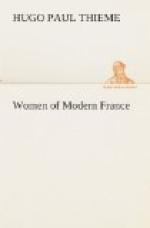In general, the women of that century “liked better to be feared than loved; they inspired mad passions, insensate devotions, ecstatic admirations. The epoch was one in which life counted for little, when balls alternated with massacres; when virtue was befitting only the lowly born and ugly (Brantome recommends the beautiful to be inconstant because they should resemble the sun who diffuses his light so indiscriminately that everybody in the world feels it). It was the age of beauty—a beauty that fascinated and entranced, but the glow of which melted and killed; but this glow also reacted upon them that caused it and they became victims of their own passions—through either jealousy or their own weaknesses. No age was ever more luxurious, pompous, elegant, brilliant, and wanton, yet beneath all the glitter there were much misery and bitter repentance; amongst the violent wickedness there were noble and pure women such as Elizabeth of Austria and Louise de Vaudemont.”
The whole century seemed to be afire and to tingle with that spirit of liberty, imitation, and experimentation, which, so often abused, led to much disaster. In spite of that unsettled and excited condition, the sixteenth century attained greater development, had more avenues of intellectual activity opened to it, imitated, thought and imagined more and produced as much as any other century; in every field, we find the names of its masters. As M. Faguet says, the sixteenth century was, in France, the century createur par excellence; and in this, woman’s part was, above all, political, her social, moral, and literary influence being less marked.
Chapter III
The Seventeenth Century: Woman at Her Best
In the seventeenth century, the influence exerted by the women of France, departing from the political aspect which had characterized it in the preceding century, became of a social, literary, religious, and moral nature, the last predominating. Inasmuch as the reins of government were in the hands of the king and his ministers, political affairs were but slightly affected by the feminine element. Woman, realizing the uselessness as well as danger of plotting against the inviolate person and power of the king, contented herself with scheming against those ministers whose attitudes she considered unfavorable to her plans.
Of all social and literary movements, however, woman was the acknowledged leader; in that institution of culture and development, the seventeenth century salon, her undisputed supremacy placed her in the position of patroness and protectress of men of letters. In the general religious movement her role was one of secondary importance; and as mistress, she ceased with the sixteenth century to be either active politically or disastrous morally and became merely a temporary recipient of capriciously bestowed wealth and favors. In order to fully comprehend woman’s position and the exact nature of her influence in this century and the following one, the position and constitution of the nobility before, during and after the ministry of Richelieu, must be studied.




